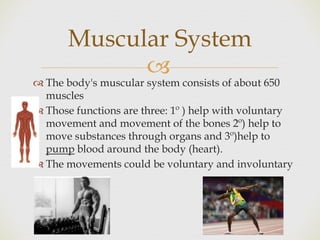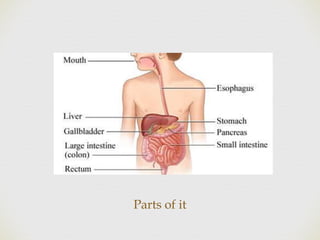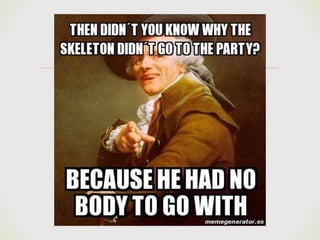Systems presentation 5º
- 1. SYSTEMS
- 2. The body's muscular system consists of about 650 muscles Those functions are three: 1º ) help with voluntary movement and movement of the bones 2º) help to move substances through organs and 3º)help to pump blood around the body (heart). The movements could be voluntary and involuntary Muscular System
- 3. Parts of it
- 4. The job of the circulatory system is to move blood, nutrients, oxygen, carbon dioxide and others around the body. It consists of the heart, blood, arteries and veins( capillaries too). Exists the blood cells that travel in the blood. Circulatory System
- 5. Parts of it
- 6. The digestive system consists of a series of connected organs that together with the urinary system allow the body to break down, then absorb food and remove waste in the end. It includes the mouth, esophagus, stomach, small intestine, large intestine, rectum, and anus. Also play a role in the digestive system the digestive juices. Digestive system
- 7. Parts of it
- 8. The urinary system helps to eliminate waste from the body, which is produced when certain foods are broken down and there are things that the body don’t use. The whole system includes two kidneys, two ureters, the bladder and the urethra. Urine produced by the kidneys travels down the ureters to the bladder, and exits the body through the urethra. Urinary System
- 9. Parts of it
- 10. Our bodies are supported (hold) by the skeletal system, which consists of 206 bones that are connected by tendons to the muscles. The skeleton not only helps us move, but it's also helps to produce blood cells and the storage of calcium. The teeth are also part of the skeletal system, but they aren't considered bones. Eskeletal System
- 11. Parts of it
- 12. The respiratory system allows us to take in (breathe in) vital oxygen and expel (breathe out) carbon dioxide in a process we call breathing. This system have the trachea, the diaphragm and the lungs. Respiratory System
- 13. Parts of it
- 14. The nervous system controls both voluntary action (like conscious movement, use a pen) and involuntary actions (like breathing), and sends signals to different parts of the body. The central nervous system includes the brain and spinal cord, then the signals pass to the nerves that connect all parts of the body to the central nervous system. Nervous System
- 15. Parts of it
- 16.















